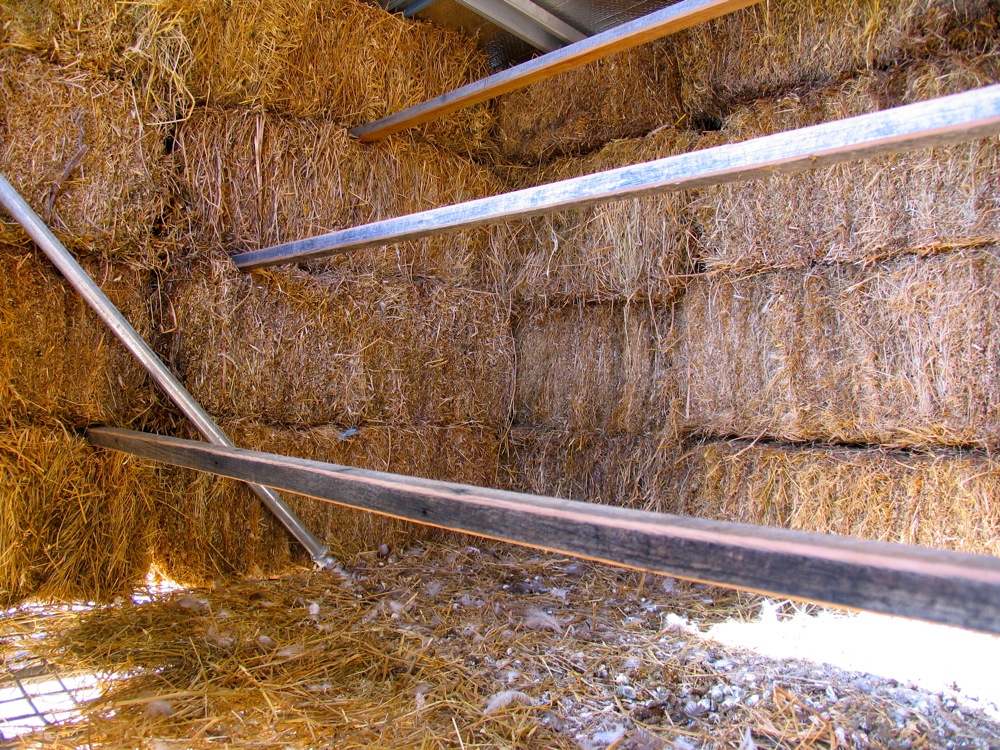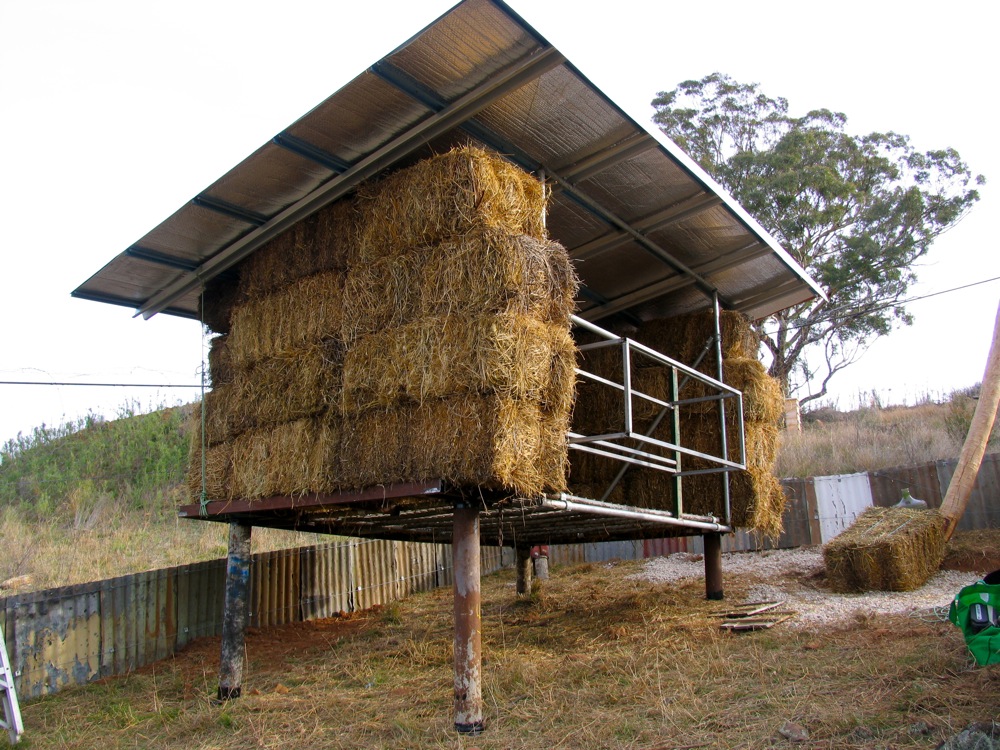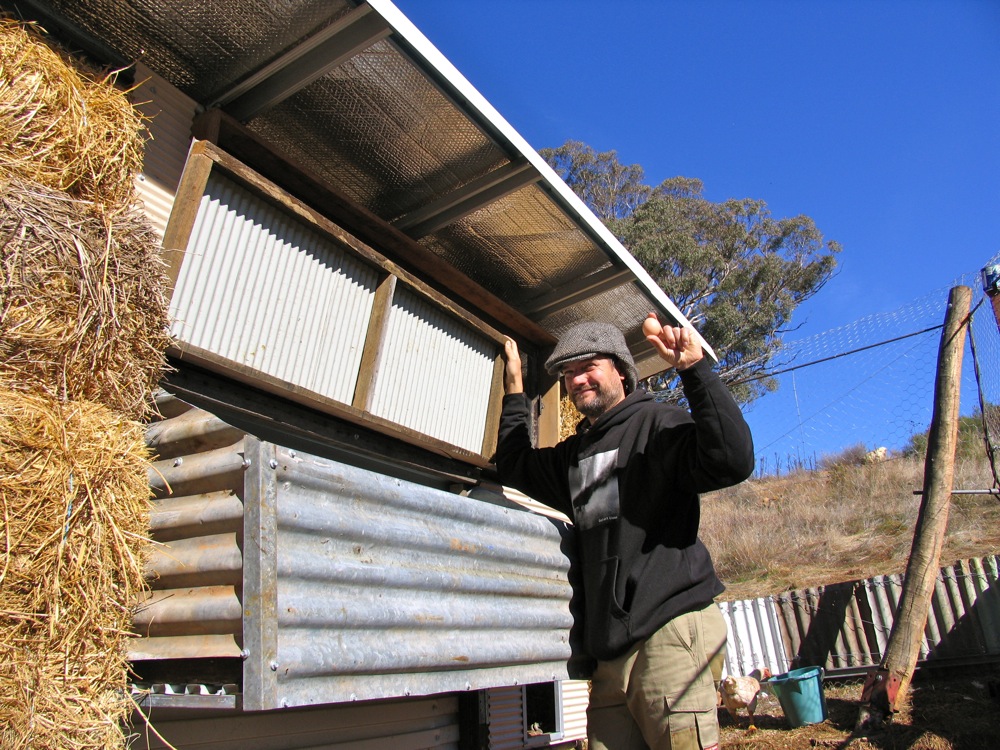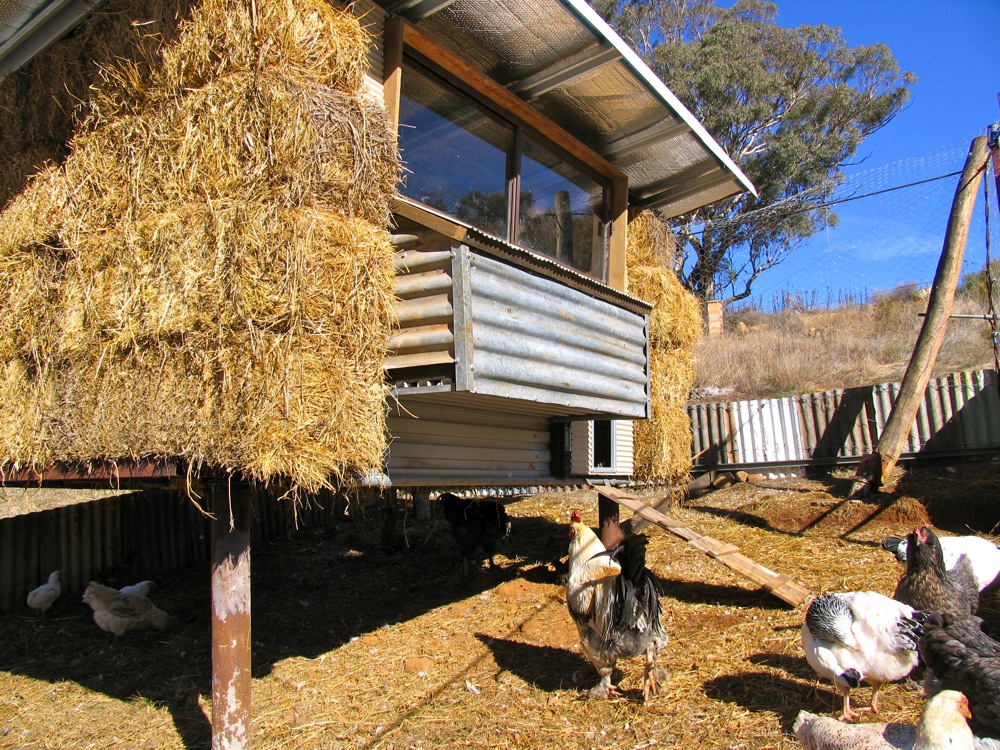 Within the Gravity Chicken Run, we needed a place for our chickens that was warm in winter and cool in summer. We also wanted it to be super easy to clean, cheap to build, and easy to keep our chickens healthy long term. So we came up with a design called the RawBale Chicken House.
Within the Gravity Chicken Run, we needed a place for our chickens that was warm in winter and cool in summer. We also wanted it to be super easy to clean, cheap to build, and easy to keep our chickens healthy long term. So we came up with a design called the RawBale Chicken House.
Making a chicken house is a bit like being able to build your own fort all over again. Except now that you’re big, you have more skills to make something that will be not only exciting, but also useful and enduring.
Rawbale Chicken House design parameters:
- Low cost
- Easy to clean
- Relatively fast to build
- Cool in summer, warm in winter.
- Use recycled materials where possible
- Super insulated for year round chicken comfort (in temperatures -11ºC to +40ºC)
The rawbale walls
Nick came up with the idea of using raw straw bales (hence the term Rawbale) as load bearing walls for the chicken house. The idea is that each year we take down the walls and use them as mulch, replacing them with new ones.
The plan is that each year the roof will be lifted off and the walls will be rebuilt, which will give our system a bunch of benefits, and a yearly influx of extra mulch..
The strawbales firstly provide the chickens with a cosy house with excellent insulation, which will keep them happy and hopefully extend their egg laying season. Secondly, by using raw bales, we’re setting up a system where the walls get replenished every year (at least) which will naturally prevent disease and mite build-up, which can be a problem with chickens.
The back wall is load bearing straw bales, and the front wall is made of scaffolding with recycled bits of tin, windows and wood. The side walls just kind of sit there, under the roof. The interlocking nature of the bales mean these side walls are plenty strong enough for their structural purpose (which is minimal).
The roof
The roof of the Rawbale Chicken House is made of a frame with roofing iron and insulation ,which is simply tied on above the straw bales, and attaches by ropes to the base of the house. It is designed to be taken off once a year to deconstruct the walls, with minimal effort (apart from a 2-person lift).
Then once those walls are replaced with new strawbales, the roof will simply be lifted on top, tied on again and all good for another year.
The floor
The Rawbale Chicken House walls sit on a grated platform (made out of old bits of metal we had here on the farm) which is elevated off the ground.
The grated nature of the floor means that, in the summer when we leave this floor bare to bring in cool air from below, the chicken’s poo falls straight through and continues down the slope incrementally.
In the winter, we’re going to cover this grate with deep litter (dry straw) that can be replenished as often as needs be, and keeps the chickens warm at night.
Siting for solar gain
We’ve designed the Rawbale Chicken House so it faces north and benefits from passive solar design with a window on the north side. The laying boxes are also on this wall, so the chickens are warm in the mornings when they lay.
The north wall of the Rawbale Chicken House has a frame that holds the window, the nesting boxes and the door. It’s the only framing in the place. The strawbales create the other three walls, and the roof rests on top of the north and south walls, tilted down on the south side and up on the north side.

North wall of the chicken house under construction. Simple scaffolding with a couple of extra bits welded on for laying boxes and window and door frame
The laying boxes
At the time of this build, our intern Kade Smith had the nifty idea to make removable laying boxes out of big plastic containers, in a way made them easy to lift out and clean. They’ve got a hole in the lid (for getting the eggs) and a hole in the front (for the chicken). They seem to be working well so far.
These laying boxes sit in a larger metal frame clad in iron with a hinged access lid. Nothing fancy but it does the trick and as said, it’s the warmest place in the morning once the sun rises (being on the north side) which encourages the hens to get in there and lay! That’s the theory, anyway.
All our chickens are now moved in and they seem pretty happy with the arrangement. I’m glad they’ll all be warm and happy over winter. And we’re even getting an egg a day! Not bad in winter weather that’s getting down to -10ºc at night sometimes….
The front door
The front door of the house is a large panel on hinges which is closed most of the time, with a small access hole for the chickens.
We leave this access hole open all the time, and just open the larger panel when we need to access the interior to rake out the litter and put new straw on the floor. Nice and simple, seems to be working.

Perches inside the rawbale chicken house. These are made of hardwood (more mite-proof) offcuts from our house.
Will this design prove to be the best thing ever? We don’t Know. It’s an experiment. What we’re trying to do here is figure out paths of effective use of energy for DIY structures that have multiple benefits. So… what do y’all think? Any suggestions or comments?
Funky Chicken House resources:
- Free Range chicken coop designs – including some of Joel Salatin’s models
- Urban strawbale chicken house that looks very cosy in Sydney
Many thanks to Milkwood Interns Kade Smith, Christian Tyler, Amelie Bischof and Belinda Joy-Sheekey and also to Wwoofers Christian Horn and David Williamson for their input and energy in the building of this fine chook hilton.
You might also like to have a look at:
- Gravity Chicken Run design
- How to build a Geodesic Chook dome
- All our posts about chickens






















Fantastic! Thank you so much, I am going to show my husband this.
My Asha & your Asher are so much alike!!
http://eatatdixiebelles.blogspot.com/2011/05/my-hobbies-are-making-my-kids-smile.html
ha ha! attack of the Asha(r)s!
Looks gorgeous guys – very cool use of the bales!
Looks good I like the grate bottom with the straw on top. Only thing I might have done different is to have the house as part of the fence with the lid to the laying boxes accessible from outside the pen. Might be nice in the wet to not have to enter the pen.
cheers michael – we give the chooks scraps every day so we get in the pen at that point anyway – and the laying boxes are within a step of the door, so it’s only just inside on a rainy day!
Great ideas!
I imagine it would be possible to hinge the roof on the fixed northern side and then use a tall pole to prop it up when it’s bale changing season, turning it into a one human operation.
I love the laying box idea – now I have to ask around and get me some of those plastic containers!
just make sure they’re food grade, and haven’t had nasty chemicals stored in them, darren!
I like the idea and I don’t. On the plus side, it’s very imaginative and I’m interested in the outcome of the rawbale trial. Where I have concerns from a permaculture point of view however, is that bales of any kind require high energy output. I both like the convenience of bales, but as time and resources have run out, I also didn’t find them a sustainable solution long term either. I’ve had to resort to natural solutions to deal with the need for mulch, such as all the weeds we pull or grass which grew so tall it had… Read more »
yeah agreed bales may not be the wall material of choice further down the track, but in our area they’re available right now in plenty and they’re a cheap, natural by-product, so they’re what we’re using. This experiment is about making a quick,viable structure out of locally available materials with temporary walls which are renewed regularly to create biomass and minimise disease while providing a non-toxic environ for our chooks… which doesnt preclude strawbales as the only wall material (in theory, anyway!)… i guess it’s always a balance of using what’s available right now and what will be renewable long… Read more »
Agreed about the shadecloth and basically anything manufactured that doesn’t come from nature. It all has a cost of energy extracted from the environment. I will disagree slightly with the comparison however, as shadecloth only has to be purchased once, while bales become an ongoing venture for as long as they are required. One has a fixed cost (and energy output) the other doesn’t. Of course I’m not a purist. I buy bags of horse poo at $1.50 a bag (which has wood shavings in it) for my biomass. The owner of the horse had to buy the shavings for… Read more »
This is brilliant. I really dig the use (which I see as a common theme!) of upcycled materials — this is something I try to maximize all the time. Wonderful design, chicken run as well. And I agree on the strawbale idea too — use them while we can since they are a by-product of local economic activity.
With a much more insulated floor and lime plastered walls this would work well here in the northern temperate forests 🙂
would you really want to lime render the walls each year after you re-build, mark? might be worth it i suppose. and yes, much more deep litter for a colder climate. ours does seem to be working tho – we’re up to 3 eggs a day now, in light snow! Cheers 🙂
You’re right — I was implying lime plastered bale walls that would be permanent. Sorta changes the function, but “up here” it’d be really beneficial.
I really like the design. My chook house is in the same shed as my hay storage and I have found that hay stored for too long will become a home for insects and that hay itch mites will move in to feed off the insect and will start to bite the chickens causing irritating itchy sores. With your design you would definitely have to change the bales at least once a year, as you plan on doing, to prevent this from happening. The open floor idea is great as the stick fast fleas will fall through the floor when… Read more »
cheers for the notes, Chris – we’ll let you know how it works come spring with the weather warming up – will be checking our chickens legs regularly!
I’d be interested to hear how the rawbale method works over four seasons. My partner build a strawbale house with metal roof for our resident pig. (We figured we’d move onto timber then brick before the wolf came howling at the door). The structure provided excellent winter insulation but in spring we discovered that mice had tunneled into the walls and were breeding up in numbers. The strawbales were re-used as mulch and pig now has a converted tank as her semi-permanent quarters. He’s also seen mice scramble up the corrugated iron apron around the enclosed veggie area and wriggle… Read more »
Hi anne, yes we’ll report back on how it goes. No probs with mice yet but it’s a possibility…
I love it. Now I just wish I had some chickens….. I’d build this sucker in a heartbeat.
great stuff.I used that idea for a mini joey house here…so joeys in care could have safe, warm,cosy quarters in our lousy south west Vic winters.Worked well..as a one – woman job..and it was a great spot for me to sit in while feeding the babes.
You inspire to have another go…with my latest brood of six roos and wallabies to raise.
Thanks annie at wallaby creek
I dont think the chickens need all the insulation,nice thought though. I would be more concerned with vermin and predators.
Ill admit i havnt done it,but mabe a bucket trap for the mice n feed them to the pigs.
My coop idea is to build one with discarded pallets and use deep bedding inside.
Enough air movement is important also.
Ive got an old wiper motor to make an auto open door,and im big on an enclosed run,so many sad storys about chickens getting eaten by critters.
What a wonderful idea! My only concern is the lower wall – because of the slope it looks like the bales will lean and eventually colapse (see 8th picture from top). Will you please comment?
One possible improvement suggestion – can you attach some guttering on the roof with a detachable downpipe that then feeds a barrel – this will then collect on site water for the chooks.
Also, does the chook house move? I wonder if it could be put on wheels so you can rotate the location.
Cheers!
I am looking over the web for straw bale chicken house designs. How did it work out for you this year? We live in a very cold and snowy place, a friend of mine suggested strawbales to keep our 6 hens warm and cozy through our 6 months winter. Any other suggestions, comments, advice, are greatly appreciated! I saw a design using old pallets for walls, and strawbales for infill, we will probably use that approach. I hope it worked out well for you this past winter. Thanks for the detailed construction advice.
Yep we were happy with it! Will continue to use this design – infill would also be a great idea, as you wouldn’t have to garner a crew to take the roof off in order to change the bales!
Look up free plans for a straw bale shelter.There are plans for a small shelter out there.Ive thought of this for either my chicks or as a warm place to sleep in.when first moving to the country.I would consider small saplings for an angle garden shed style roof and put bales on the roof.(make sure they well stay dry!)under steel roofing.
Front seems sturdy enough to hinge the roof. I would recommend a small pulley attached to the front edge of the roof, with a rope secured through the pulley and to the floor. The loose end of the rope could then be pulled down and tied securely while the bales are quickly switched out.
I live in a house not much bigger than that. i imagine they would feel cozy. i sure do.
I love the simplicity and the heating/cooling aspects. In our area, racoon’s would easily enter through the cracks. An inner protection frame held together with simple cotter pins might do the trick. (Like an oversized dog pen). The mesh would need to be 1-2″ depending on the pest. Chicken wire is not sufficient in our area..1″ or less soil screen mesh would be solid, but heavier. For the roof, you could upgrade to a passive solar heat. The best design I’ve seen uses 2×4 frame, two layers of screen door mesh, and clear plastic or glass roof panels to seal… Read more »
Hey Kory, the chookhouse is in a predator-proof chicken run – it’s not designed to be predator proof… And our summer’s are very hot, so the insulated shade of the roof is part of keeping the chookies happy and healthy 🙂
Yep, straw bales wouldn’t stop much. But covered? Chicken wire dosen’t stop coons either. I like strong wire that dosen’t leave room for paws to get through. And an electric fence. Straw bale sure is good for insulation! Wire coated with a clay mud type mix and a fence charger.
awesomeness, I want one!
I am so going to try this. I wanted to do a straw bale chicken house for noise insulation since i will be having some roosters and we have now houses close instead of an empty lot. I might eventually do a more permanent one, but am using straw for deep litter anyway. Thanks for sharing!
Wouldn’t predators be a problem with this type of design?
it’s surrounded by a floppy fence, and we don’t have eagle problems where we are, so no –
So you don’t have problems with foxes or Coons or nothing? Wow, would are so lucky!
haha no coons on this continent, but feral foxes, yes. The house has a high ‘floppy fence’ around it – https://www.milkwood.net/2011/05/18/gravity-chicken-run-design/
I love this idea , very similar to what some alberta farmers do with their cattle they create a large enclosed on 3 sides shelter for the cattle that winter out with their large square straw bales . Makes a great shelter and they just tarp the roof .